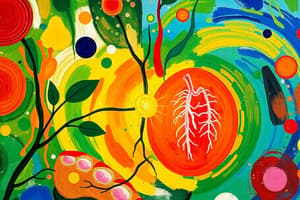Podcast
Questions and Answers
What is the primary function of photosynthesis?
What is the primary function of photosynthesis?
- Breaking down organic compounds
- Generating ATP
- Converting light into chemical energy (correct)
- Producing oxygen
Where does photosynthesis primarily take place in plants?
Where does photosynthesis primarily take place in plants?
- Cytoplasm
- Chloroplasts (correct)
- Cell membrane
- Mitochondria
What is the main waste product of photosynthesis?
What is the main waste product of photosynthesis?
- Oxygen (correct)
- Carbon dioxide
- ATP
- Glucose
What is the role of chlorophyll in photosynthesis?
What is the role of chlorophyll in photosynthesis?
Which process primarily involves producing organic compounds from sunlight?
Which process primarily involves producing organic compounds from sunlight?
What is the key function of ATP in photosynthesis?
What is the key function of ATP in photosynthesis?
During which stage of cellular respiration does glucose get broken down to pyruvate?
During which stage of cellular respiration does glucose get broken down to pyruvate?
Which compound is formed during the citric acid cycle in cellular respiration?
Which compound is formed during the citric acid cycle in cellular respiration?
Where does oxidative phosphorylation occur in cellular respiration?
Where does oxidative phosphorylation occur in cellular respiration?
What is the role of oxygen in cellular respiration?
What is the role of oxygen in cellular respiration?
Which process releases CO2 back to the atmosphere in cellular respiration?
Which process releases CO2 back to the atmosphere in cellular respiration?
What happens if cellular respiration and photosynthesis cease to occur?
What happens if cellular respiration and photosynthesis cease to occur?
Flashcards are hidden until you start studying
Study Notes
Photosynthesis and Cellular Respiration
Photosynthesis and cellular respiration are two fundamental processes that underpin life on Earth. They are directly connected by the law of conservation of matter and energy; what one process gains, the other loses. While they both involve exchanging carbon dioxide and oxygen, photosynthesis is primarily concerned with producing organic compounds from sunlight while releasing oxygen, whereas cellular respiration involves breaking down these compounds, generating ATP and consuming oxygen. Let's take a closer look at each process.
Photosynthesis
In simple terms, photosynthesis is the conversion of light into chemical energy through a series of complex reactions involving chlorophyll and pigments in plants and some microorganisms. This energy is used to produce glucose and other sugars, which can later be consumed for growth and reproduction.
The primary steps of photosynthesis occur within specialized cells called chloroplasts found inside plant cells. Here, light energy absorbed by chlorophyll molecules excites electrons, causing them to move along a chain of electron carriers, ultimately transferring their energy to a protein named ATP synthase. This movement generates ATP, the main source of energy currency just like ADP in animal cells. Additionally, photosynthesis produces oxygen as a waste product, making it crucial for aerobic respiration.
Cellular Respiration
Cellular respiration is the process by which organisms release stored energy from nutrients to fuel metabolic activities. It occurs in three stages: glycolysis, citric acid cycle (also known as Krebs cycle or TCA cycle), and oxidative phosphorylation. These stages are interconnected but operate sequentially and can be performed in any order depending on the availability of substrates and cofactors.
Glycolysis takes place both in the cytoplasm and mitochondria. In this stage, glucose is broken down to pyruvate, generating ATP. If there is enough oxygen available, pyruvate enters the mitochondrion where it is further oxidized during the citric acid cycle, which forms a high-energy compound called NADH+H+. As NADH donates its protons across the inner membrane, ATP is generated via oxidative phosphorylation due to the electrochemical gradient created by the transported protons. This process releases CO2 back to the atmosphere to balance out the reaction when considering the overall equation.
Summary
While photosynthesis converts light into chemical energy and produces oxygen, cellular respiration breaks down those chemicals, utilizing oxygen to generate ATP for cellular functions. Both processes follow the principle of the conservation of mass-energy and are essential for maintaining life on our planet. Without either process occurring, life would cease to exist.
Studying That Suits You
Use AI to generate personalized quizzes and flashcards to suit your learning preferences.




